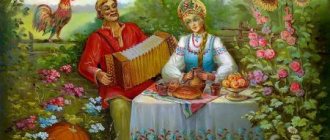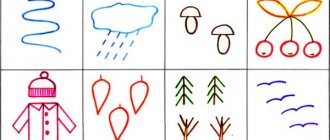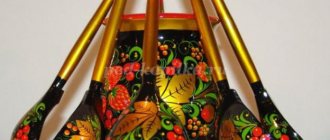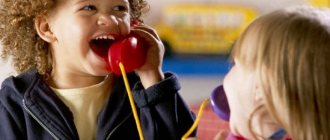Work experience “Oral folk art in the development of children’s speech activity”
— determine the importance of oral folk art in the development of speech
preschoolers;
-improvement of dialogic and monologue speech;
- education of aesthetic feelings when getting acquainted with examples of oral folk art;
-increasing the competence of parents in the development of children’s speech;
— conduct a study of the influence of oral folk art on the development of children’s speech activity.
To achieve the set goal and solve problems, an appropriate developmental subject-spatial environment has been created in the group.
The interior of the group includes elements of Russian decorative arts and crafts: aids in play corners, soft toys made of fabric, various types of theaters, folk dolls. In addition, a large role is given to folklore in the planning of educational activities and regime moments. Understanding that improving verbal communication is impossible without expanding the child’s vocabulary, much attention is paid to consolidating and activating it. Classes on cognitive development with elements of folklore, in which children became acquainted with the attributes of the upper room, significantly expanded the children's vocabulary. In order for new, rather difficult words to become firmly established in children’s vocabulary, she used various methodological and gaming techniques.
Children's acquaintance with folk art begins with nursery rhymes and
lullabies
. Getting to know nursery rhymes begins with looking at pictures, illustrations, and toys. Having given the children the opportunity to examine the toy, I tell them about the character in the nursery rhyme and his features. In a preliminary conversation, I explain the meaning of the new words that the children will hear in a nursery rhyme. Before reading the nursery rhyme “Horse” to children, they already had an idea of what a beautiful, proud animal this is. While washing and combing the children's hair, she introduced them to songs.
It’s nice to watch how children use nursery rhymes while playing “mother-daughter” and how carefully and lovingly they treat their dolls.
The children have grown up. I began to select nursery rhymes for them with more complex meanings. During the theater classes for children, the task was set not only to remember the nursery rhyme, to read it emotionally, but also to act it out themselves. The whole group of children learned to move and talk like a fox, a hare, a bear, a chicken, a hedgehog, etc., depending on who the nursery rhyme is about. Folklore provides excellent examples of Russian speech, imitation of which allows a child to more successfully master his native language.
Proverbs and sayings are called the pearls of folk art; they affect not only the mind, but also the feelings of a person. The teachings contained in them are easily perceived and remembered. Proverbs and sayings are figurative, poetic, endowed with comparisons, vivid epithets, they contain a lot of personifications and small definitions. The proverb can be used in any situation. The children are going for a walk. We remind the slow Artem: “Seven do not wait for one.” Noticing that Sasha dressed sloppily, we say: “If you hurry, you’ll make people laugh.” During walks, proverbs help children better understand various phenomena and events..






